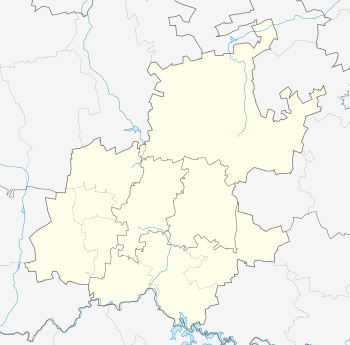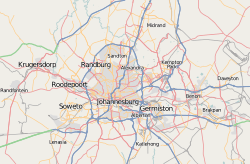Parkhurst, Gauteng
| Parkhurst | |
|---|---|
 Parkhurst | |
|
Location within Greater Johannesburg  Parkhurst  Parkhurst Parkhurst (South Africa)  Parkhurst Parkhurst (Africa) | |
| Coordinates: 26°8′18″S 28°1′4″E / 26.13833°S 28.01778°ECoordinates: 26°8′18″S 28°1′4″E / 26.13833°S 28.01778°E | |
| Country | South Africa |
| Province | Gauteng |
| Municipality | City of Johannesburg |
| Main Place | Randburg |
| Area[1] | |
| • Total | 1.64 km2 (0.63 sq mi) |
| Population (2011)[1] | |
| • Total | 4,851 |
| • Density | 3,000/km2 (7,700/sq mi) |
| Racial makeup (2011)[1] | |
| • Black African | 20.4% |
| • Coloured | 1.6% |
| • Indian/Asian | 2.5% |
| • White | 73.8% |
| • Other | 1.7% |
| First languages (2011)[1] | |
| • English | 71.0% |
| • Afrikaans | 10.1% |
| • Zulu | 4.0% |
| • Xhosa | 2.1% |
| • Other | 12.8% |
| Time zone | UTC+2 (SAST) |
| Postal code (street) | 2193 |
| PO box | 2120 |
Parkhurst is a small, but dense northern Johannesburg suburb, Gauteng Province, South Africa of about 2000 households and 4000 residents.
Although, it is mainly residential with many people working from their home, there are two main business roads - 4th Avenue which has the restaurants, cafes and décor, design, antique and service shops; and 6th Street which is quickly becoming converted into a design, décor, art and small business area. Parkhurst is popular with Johannesburg's residents for its street life and sidewalk cafes, with an atmosphere similar to Greenside and Melville.
Parkhurst is most famous for its 4th Avenue. It is a popular tourist and weekend location. The Jolly Roger[2] and Espresso[3] are two of the streets long standing establishments. More recent, successful restaurants to the street include Hudsons Burgers, Nice, Vovo Telo, Coobs, Rockets and Craft.
Verity Park is a Parkhurst attraction. The park was originally the home of the Parkhurst Soccer Club, however, the club moved in the 1970s. Verity Park is also known as a dog haven and draws many residents wishing to walk their dogs.[4]
It was founded in 1904 by the African Realty Trust who developed a small farm into 2200 stands. About a third of the suburb was developed by the 1930s and it was completely developed after World War II . The gentrification or Chelseafication process started in the 1960s when the older houses in the southern section started to be renovated. This process continues to this day with many properties being re-modelled and renovated several times over. There is an active residents' association, the Parkhurst Residents and Business Owners Association (PRABOA), who try to preserve the suburb's village-like atmosphere.
Although erroneously included by Google Maps as part of Randburg, Parkhurst has never been part of that area.
References
- 1 2 3 4 "Sub Place Parkhurst". Census 2011.
- ↑ "Jolly Roger (Parkhurst) reviewed". Food 24.
- ↑ "Espresso Caffe & Bistro (Parkhurst)". Eat Out.
- ↑ "vERITY PARK". Parkhurst.Org. Archived from the original on 2011-01-30.
External links